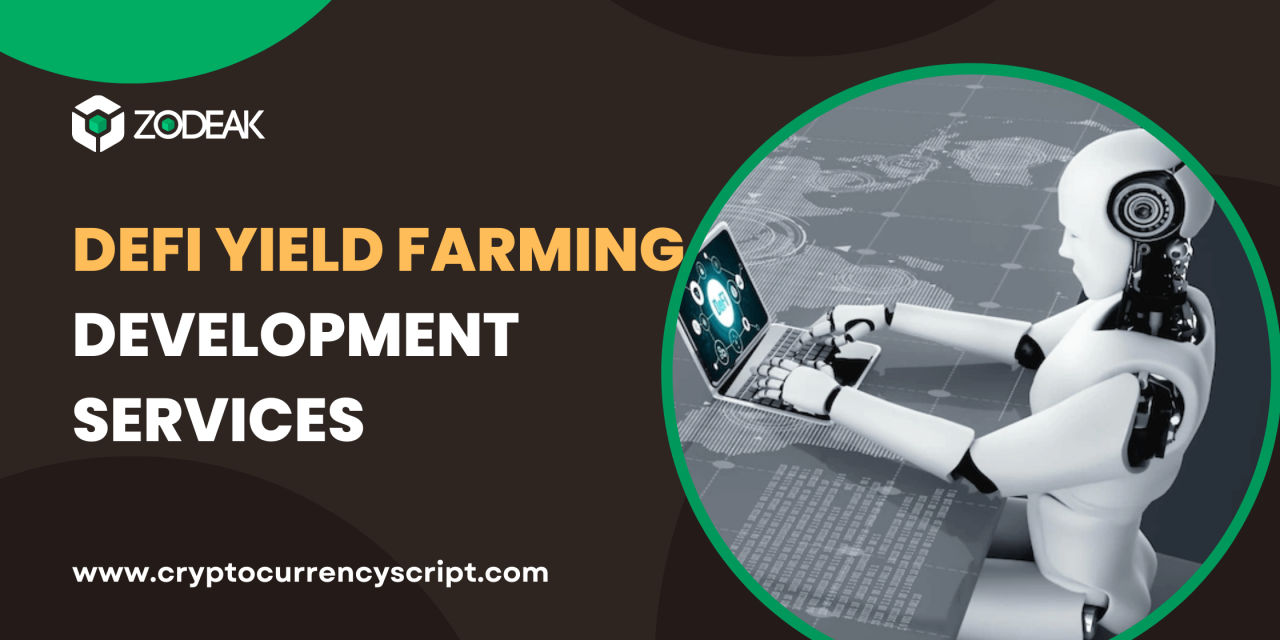DeFi Yield Farming Development
DeFi Yield Farming Development has become the rocket fuel of the DeFi Economy and grab the attention of many crypto users in the world. Because of the positive presence of sparkle in the crypto world, Decentralized Finance (DeFi) is getting enlarging and is the latest hype machine nowadays.
Compared to Blockchain & Cryptocurrency, DeFi plays and stands in the hottest position. Also, this DeFi platform revamps the financial infrastructure and process with more advanced techniques.
In this article, we are going to see what is DeFi Yield Farming? And How this concept helps the average crypto user.
DeFi – Short Overview
DeFi is the short term of Decentralized Finance, Also it is denoted as Decentralized open Finance. Decentralized Finance can build an alternate financial infrastructure to the endowment system which covers banks, insurance companies, exchanges, and much more., These DeFi-related protocols can be exerted without approval, because of the decentralization system.
Get more information about DeFi read more: Decentralized Finance – An Ultimate Guide for Crypto Startups
What is DeFi Yield Farming?
DeFi YieldFarming is the ultimate strategy to generate rewards by empowering cryptos in the market of DeFi. Simply said, DeFi Yield Farming demonstrates holding the digital assets and getting a fixed interest or rewards.
DeFi offers user incentives to deposit tokens and renders liquidity to the DeFi protocols commonly called Yield Farming. Another name for Yield Farming is called Liquidity mining and this is the growing method of receiving rewards from crypto capital speculations.
How does DeFi Yield Farming work?
YieldFarming is not investing in cryptocurrencies, tokens, and stablecoins. It actually demonstrates that lending digital assets in DeFi protocols assist in creating opportunities to gain rewards and interests.
In this Yield Farming, “Farming” relates to the gathering high percentage gain generated by offering liquidity for various DeFi ecosystems.
In this DeFi world, Farmer of the Yield is playing a major role in the bank and lending their funds to improve the use of tokens and coins in the DeFi marketplace. That DeFi protocol turns and generates yield for the lender.
This YieldFarming ecosystem is carried out with a Blockchain-powered Smart contract that merges lenders and borrowers and that wages to be remunerated for the investors.
DeFi Yield Farming Tokens – What is that?
DeFi Yield Farming tokens or digital assets contribute a set of financial value and gain access to auspicious opportunities. These tokens are controlled with the help of smart contracts that could be run on the Blockchain networks. This will bring internationalized economic investors towards the DeFi Yield Farming ecosystem.
Here is the list of DeFi Yield Farming Tokens, they are,
- COMPOUND DAI – COMP Token
- Maker – MKR
- Kyber Network – KNC Token
- Synthetix – SNX Token
- Aave – LEND Token
- UMA- UMA Token
- Loopring – LRC Token
Roles of Smart contract in DeFi Yield Farming Development Services
The entire functionality of the Yield Farming platforms is contributed with the help of smart contracts which are the building blocks of the platform. This platform is based on the self-executing smart contracts built on the various blockchain networks.
If both the conditions are met in the Yieldfarming platform, the smart contracts will automatically execute and make transactions. After launching the DeFi Yield Farming Development Platform, you need to double-check or inspect the smart contracts for your Yield farming projects.
To create, develop, and deploy such smart contracts, Solidity – the Ethereum Programming language is specifically used. A vast number of DeFi products that implement Yield Farming make use of Ethereum Blockchain for constructing Smart contracts.
Roles of Liquidity providers in Yield Farming
Without liquidity providers, Yieldfarming is not attainable for those who venture their deposits into liquidity pools. This liquidity pool acts as a smart contract where a buyer and seller agreement is encoded and available in the decentralized blockchain platform.
Some of the foremost mining platforms are,
- Compound
- Yearn Finance
- Uniswap
- Maker DAO
- Curve Finance etc.,
How are the Returns of Investment(ROI) calculated in DeFi Yield Farming?
These DeFi Yield farming returns are calculated annually. Prevalently used metrics of DeFi Yield Farming platforms are Annual Percentage Rate (APR) and Annual Percentage Yield.
Annual Percentage Rate(APR)
This formula refers to the annual rate of returns that are enforced on lenders but the wages were paid to capital investors. The most important feature is that the interest acquired is not to buy assets in the investment plan to make more interest.
Annual Percentage Yield(APY)
This Annual Percentage Yield is determined by an annual rate of return that might be changed on capital lenders and paid to the capital providers lately. APY is not an explicit APR, but only the former of the platform permits compounding of interest that brings in more returns to the investors of the platform.
Why Choose Zodeak for the best DeFi Yield Farming Development Services?
We are Zodeak – the leading DeFi Development Services that renders the complete solution of DeFi Yield Farming Development Services and Solutions to the crypto people all over the world.
We offer highly innovative features and functionalities that ensure you provide high-end technologies implemented in our DeFi solutions. With the help of our well-developed team of blockchain, experts assist you to offer top-notch services to launch your own DeFi Yield Farming Development.
We also offer end-to-end solutions of our DeFi solutions such as,
- DeFi Smart Contract
- DeFi Token Development
- DeFi Dapp Development
- DeFi Lending & Borrowing Platform Development
- DeFi Wallet Development
- Decentralized Exchange Script Development and much more.,
Get a Free quote from our Business experts via,
Email: [email protected]
Whatsapp/Telegram: +91 9360780106
FAQ – DeFi Yield Farming Development Services
Yield Farming in DeFi is demonstrating the process that stands for receiving the most elevated yield and a technique to earn more cryptocurrency with the help of your crypto assets.
A liquidity Pool is a collection of funds locked in a yield farming smart contract. They meant to enable decentralized trading and lending.
Time of Development depends on the features that you want to integrate into your platform. Share your business necessities and we will instruct you on the evaluated time to build your DeFi Yield Farming software.
1) Chainlink
2) Uniswap
3) AAVE
4) DAI
5) Maker







